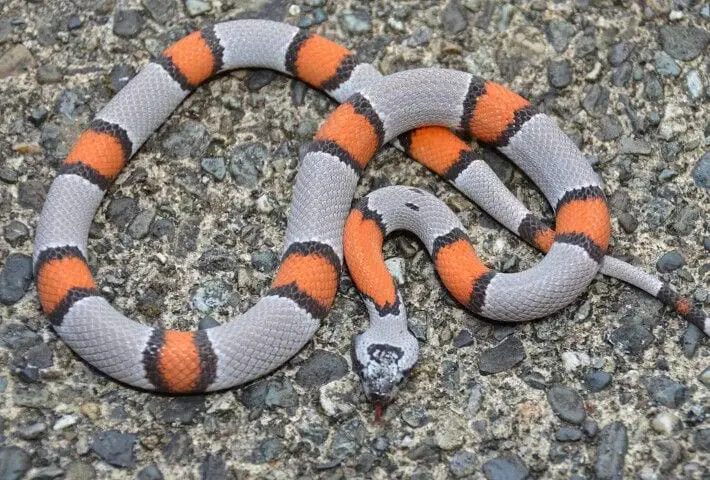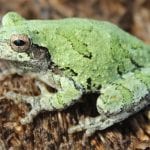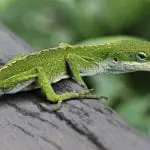Scientific Facts
| Common Name: | The gray-banded kingsnake, Alterna, or Davis Mountain Kingsnake |
| Scientific Name: | Lampropeltis alterna |
| Life Span: | Around 30 years |
| Length: | Around 3 feet |
| Habitat: | Rocky deserts |
| Country of Origin: | Texas, New Mexico, and northern Mexico |
Physical Description
The gray-banded kingsnake is one of the snake species that are good to keep as pets. They do not grow too large, and they are typically easy to feed. Compared to other snakes, it has a wider head and round pupils inside its large eyes. This kingsnake has beautiful coloration with patterns that tend to vary greatly. It morphs into two main color morphing: the first is a red and orange banding called “blairi,” while the second is called “alterna” which means white and black accenting. This mixture of colors varies on patterns, and some lack red and orange entirely.
In terms of size, they can grow from 10 inches when they are hatchlings up to 3 feet. The maximum recorded length is 57 inches, but most of those in the captive range from 24 to 36 inches.
Conservation Status
The gray-banded kingsnakes are considered by the IUCN’s Red List to be a species with the least concern for extinction. Locally, the reptile is declared as endangered by New Mexico.
Life Span
If you can provide your pet gray-banded kingsnake the best of care, gray-banded kingsnakes can live up to thirty years old.
Availability and Natural Habitat
These gray-banded kingsnakes are normally found in the rocky areas found in the Chihuahuan Desert. They are also naturally found in Northern Mexico, New Mexico, and Texas. But because of their beautiful colors, this specific breed is one of the most sought after breeds of snake that is being kept in captivity.
Behavior
These snakes are known for being obedient and easy to tame. They are also quite easy to train, especially in feeding times and schedules. This is one of the reasons why this breed is perfect if you are a first-time snake keeper. But, if it is really your first-time to try taking care of snakes, make sure that the one you chose already had the experience of feeding on mice.
Diet
Gray-banded kingsnakes usually enjoy feeding on mice and other usual reptile foods. To get them started, though, a few lizards would be nice. Then, introduce them with mice and rats, which would be their permanent meals for the rest of their lives. For hatchlings, feed them with a naked pink mouse. Juvenile gray-banded kingsnakes must be fed with fuzzy baby mice, while adults normally feed on small adult mice.
Eating Habits
Feeding gray-banded kingsnakes must be done two to four times per month during the first three seasons of the year and stopping the feeding every winter.
If you notice your pet snake not interested in eating the mice, there are some tricks that you can apply. One thing that most keepers do is rubbing the cloacal region of the lizard on the mouse so that the mouse can carry the scent of the snake. Also, to trick the snake that the prey is alive, you can jiggle the mouse a bit using some forceps.
Development and Reproduction
The gray-banded kingsnake usually produces clutches of eggs. In one laying, there might be a variety of 3 to 13 eggs, depending on the copulation results. An egg that has been laid usually hatches after 9 weeks. When hatched, these baby gray-banded kingsnakes are usually as long as 25 centimeters or 10 inches long.
Common Health Problems
In general, gray-banded kingsnakes are a fairly resilient and robust breed of snakes. They can easily adapt to other forms of reptile habitats, but they can still be exposed to other forms of health concerns. Here are some to watch out for.
1) Shedding Problems
The main problem of gray-banded kingsnakes involves the shedding of their skin. This is mainly due to the fact that their skin is thinner compared to other forms of snakes. As an owner, this is why you should pay special attention to the shedding habits of your pet snake. If you see your snake preparing for shedding and then encountering some problems, you should bring your gray-banded kingsnake to a specialized reptile veterinarian.
If you are facing a shedding problem with your pet snake and you see that the old skin is stuck, find a water container where the snake can fit when it is coiled. Then, add some warm water that is about ½ inch depth. Make sure that the temperature ranges from 82 to 88 degrees Fahrenheit. The lubrication from the water may help your pet recover and remove the excess skin.
2) Infectious Diseases & Parasites
Whether external or internal, parasites are a major issue for gray-banded kingsnakes. Usually, the external ones are mites and ticks that stick to the scales of the snakes. These mites are painful, and they suck the blood from the gray-banded kingsnake.
If your snake has a mite problem, you might see a group of black, white, or red dots that crawl all over the body of your pet. This issue can be addressed by some anti-mite solutions. To avoid this, you should remember to quarantine a new pet snake for about three to four weeks, so you can monitor any underlying health conditions.
If you suspect that your gray-banded kingsnake is suffering from some parasites, especially internal ones, your trusted veterinarian can assign laboratory tests to measure this concern. Should the tests return positive, the veterinarian will also be able to issue some treatments.
Handling
One of the great reasons to have these snakes as pets is that they enjoy being gently handled by their human keepers. When you hold the gray-banded kingsnake, just let it slither about in your hand without any forms of restraint. Do not grip the snake too tightly so that it will not feel threatened and scared.
If your snake feels threatened, it might give you a tiny bite, or it might release an unpleasant scent to show you that it is not happy with the situation.
Caging
For maintaining gray-banded kingsnakes, a simple cage can work exceptionally well. All snakes are great escape artists, so you have to make sure that the covers are done well with no means to escape. Even the littlest opening can serve as a way for your snake to escape and disappear. This is a serious situation to avoid, especially if you own cats, dogs, and small children.
The usual size for a gray-banded kingsnake is a 10-gallon tank that is designed for reptiles. These enclosures are easy to clean and great for regulating temperatures.
When the gray-banded kingsnake rests, they enjoy a space where they are hidden from the eye of humans and strangers. You can provide them two hide boxes. One in the warmer area of the enclosure, and another on the opposite colder side.
Substrate
For terrarium substrates, you can use shavings, paper towels, and newspapers. As a way to maintain cleanliness, it is important to spot-clean the substrates at least two times a week and to replace the entire set of substrates about every two months. Never allow dirty substrates to last long in the enclosure because it will lead to a build-up of harmful bacteria that can lead to snake illnesses or even death.
For cleaning the terrarium, mix a solution of 95 percent of water and 5 percent bleach with a few drops of liquid soap. This solution must be applied to rinse out the entire cage before you place the new substrates. Also, use this solution to clean the snake’s water bowl and hiding area.
Before placing everything back to the cave, make sure that you dry everything first.
Lighting and Temperature
To provide your gray-banded kingsnake with a healthy living space, create a thermal gradient in its enclosure. One way to do this is by placing a heating pad or a heat tape under one side of your snake’s cage. To partner with this, also install a thermostat for easier monitoring and maintaining the ideal temperature levels.
The best level of temperature would be 65 degrees Fahrenheit on the cooler end and 88 degrees Fahrenheit towards the warmer end. If you see your snake constantly moving in its enclosure and finding it harder to settle, slightly adjust both the temperature on both ends.
Another way to aid your snake’s health using temperatures is to cool the temperature down even more during the winters. This will allow the snake to experience a similar climate to its natural habitat. To start this, maintain warm temperatures but stop feeding the snake 14 days before lowering the temperatures down. This allows the kingsnake to clear its digestive system. After that, clean the cage, replace the substrates, and allow the cage to be as cool as 55 degrees Fahrenheit.
In terms of lighting, kingsnakes usually do not rely on this, and they do not tend to have basking behaviors. Hot lights or specialized bulbs are not required as an extra heat source.
Humidity
To maintain humidity, place a damp plastic box with damp paper towels inside. The cover must have a hole that is similar to the size of your pet, and it will also serve to help boost humidity inside the living space.
Fun Facts about the Gray-banded Kingsnake
- The gray-banded kingsnake is a nocturnal creature, meaning it is more active during the nighttime.
- The gray-banded kingsnake prefers to be in solitary rather than spending time in groups of snakes.
- The gray-banded kingsnake belongs to the Family of Colubridae, Genus of Lampropeltis, and Species of Alterna.
- These snakes are oviparous, which means the female gray-banded kingsnake gives birth to eggs, and these eggs take time before hatching.
- Gray-banded kingsnakes are known to live in boulder piles, rocky slopes, mountain ridges, and rocky canyons.
- Sometimes, the gray-banded kingsnakes eat frogs, too.
- The gray-banded kingsnake is close relatives with the scarlet kingsnake, prairie kingsnake, mole kingsnake, speckled kingsnake, and red milk kingsnake.
- Gray-banded kingsnakes are distinguishable for their large round pupils.
- In Texas, gray-banded kingsnakes can legally be collected for captivity as long as you possess a hunting license.
- In Texas, the gray-banded kingsnakes are mostly seen in Big Bend, Kinney, Edwards, El Paso, and Hueco mountains.
Where Can You Get a Pet Gray-banded Kingsnake?
If you want to get a gray-banded kingsnake to keep as a pet, they are usually readily available at specialty reptile stores, online reptile breeders, reptile expos, and reptile event shows. Usually, they can be bought for as low as 25 dollars, but prices are usually even higher than that. For locality-specific gray-banded kingsnakes, the prices can be higher because the breeder takes more time to take care of the snakes and have invested more money.
How to Care for a Pet Angolan Python?
The gray-banded kingsnake is a great first-time pet for amateur or aspiring snake keepers. They are quite small, and they are known for being very easy to tame. They are really non-aggressive, and they are very easy to handle. But, they are very quick in their movements, so the owner must remember to stay alert because these snakes are great at escaping. Whenever you are planning to approach them, do not try to touch their heads and carry them from their side or their back. As much as you can, limit your handling to about half an hour at a time, and only a few times in a week.
Finally, if there are things that you feel unsure of or if you feel something unusual about your snake, contact your trusted exotic pet veterinarian to give you the proper advice.
Frequently Asked Questions
Are gray-banded kingsnakes venomous?
These friendly snakes are not venomous, and they do not pose any form of danger to humans.
Are gray-banded kingsnakes good to keep as pets?
The gray-banded kingsnakes are ideal pets because they do not grow too big or too heavy, and they usually have easy to tame behaviors.
How long do gray-banded kingsnakes live?
On average, the gray-banded kingsnakes an average of 15 to 20 years, but this can go up to 30 years if under proper care.
Why are gray-banded kingsnakes called kingsnakes?
The gray-banded kingsnakes are considered kings because they are immune from the venom of other snakes and are not to occasionally feed on other snake breeds.
Where do gray-banded kingsnakes live in the wild?
The gray-banded kingsnakes are usually seen in mountains, deserts, and canyons.
What do gray-banded kingsnakes eat when they are in the wild?
The usual meals of these gray-banded kingsnakes are small rodents, lizards, and other snakes.
Do gray-banded kingsnakes require UVA and UVB lighting?
These snakes do not need UVA or UVB lighting, but you can install UVB lighting as a supplementary heat source.
How do you distinguish the male gray-banded kingsnakes from the female ones?
Usually, they are distinguished from their sizes, as females are larger than males.
Can I touch my gray-banded kingsnake?
You can touch and handle these kingsnakes, but be careful, gentle, alert, and limit your time spent in handling.
How often does a gray-banded kingsnake eat?
The young gray-banded kingsnakes should be fed every 5 to 7 days, while the adult ones can be fed once every two weeks.



